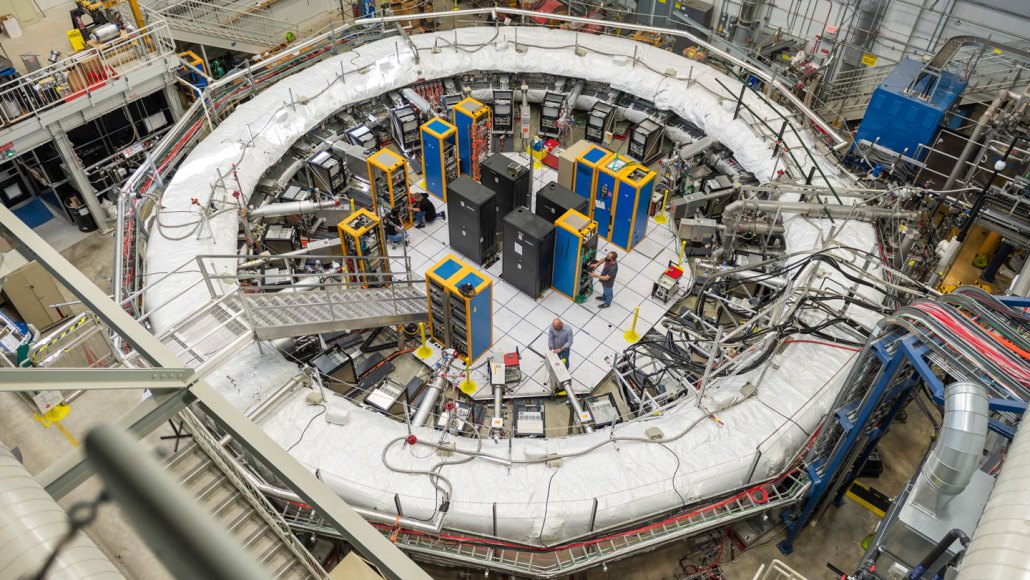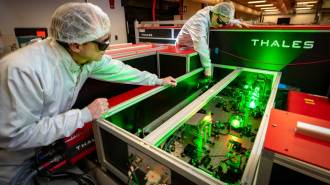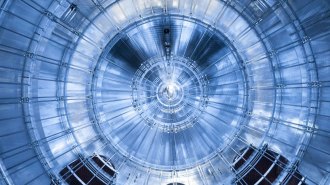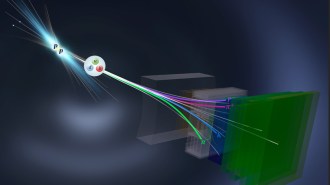Muons’ magnetism matches theory, easing an enduring physics conundrum
New results mend a decades-old crack in the standard model of particle physics, but some questions remain

The Muon g−2 experiment studied how muons wobble in the strong magnetic field of a giant, doughnut-shaped magnet (shown).
Ryan Postel/Fermilab
One of the most enduring mysteries of particle physics may be finally resolved, two new studies suggest. The oddities of muons, subatomic particles that are relatives of electrons, are starting to make sense.
Muons have an internal magnetism that scientists have struggled to pin down: Measurements of a magnetic quirk of the particles have long clashed with theoretical predictions.
Now, scientists report the most precise measurement yet of that property, the anomalous magnetic moment of the muon, which tweaks the strength of muons’ internal magnets. Meanwhile, a team of physicists updated their theoretical prediction of that tweak based on the standard model, the highly successful theory that describes subatomic particles and their interactions. That prediction shifted from the previous estimate, erasing the longstanding discrepancy. “That’s another triumph of the standard model,” says Bhupal Dev of Washington University in St. Louis, who was not involved with the two studies.
It’s a bittersweet development for physicists like Dev who search for cracks in the stalwart standard model in hopes of finding another theory that will supplant it. The disagreement between measurements and predictions has inspired perhaps hundreds of papers, many proposing new theories purporting to explain the mismatch, Dev says. Those theories are now nixed, dashing the hopes of the physicists who created them.
The frenzy began nearly 25 years ago, when the first hints of the discrepancy appeared in an experiment at Brookhaven National Laboratory in Upton, N.Y. Now, Dev says, “it’s finally coming to a close.”
Muons’ magnetism causes them to wobble when traveling through a magnetic field. The Muon g−2 experiment (pronounced “g minus two”, the term used in equations to represent the anomalous magnetic moment) measured the rate of these wobbles in a giant, doughnut-shaped magnet, revealing the anomalous magnetic moment.
The new measurement has an uncertainty of just 127 parts per billion or about 13 millionths of a percent. “It’s one of the most precise measurements that humans have ever made about our fundamental world,” says theoretical physicist Tom Blum of the University of Connecticut in Storrs, who was not involved with the measurement. The experiment’s precision surpassed what the scientists had planned to achieve, researchers reported June 3 in a paper posted at the experiment’s website and during a scientific seminar at Fermilab, in Batavia, Ill., where the experiment is located. “We have done it,” says Muon g−2 collaborator Thomas Teubner, a theoretical physicist at the University of Liverpool in England.
The result was consistent with previous measurements of the muon’s anomalous magnetic moment. But “from the theory side… things have changed dramatically,” says Blum, a member of the Muon g−2 Theory Initiative, which compiled the theoretical prediction. New developments have brought that prediction in line with experimental measurements, the group reports in a paper submitted May 27 at arXiv.org.
The shift comes from one particularly challenging bit of the calculation. That piece of the calculation accounts for an effect called hadronic vacuum polarization. To fill in that piece of the puzzle, scientists previously relied on experimental data as an input to the calculation, collected from a variety of experiments involving electrons colliding with their antimatter counterparts, positrons. But a recent experiment called CMD-3, at the VEPP-2000 particle collider in Novosibirsk, Russia, threw a wrench in that data-driven strategy when it disagreed with older experiments. That meant that the data wasn’t understood well enough to use as an input to the calculation.
As an alternative, researchers have now calculated the hadronic vacuum polarization term from scratch, without input data, using a technique called lattice quantum chromodynamics. The technique is based on the theory of quantum chromodynamics, which describes the business of quarks and gluons, subatomic constituents of protons, neutrons and other particles. In order to make the complex calculations possible, lattice QCD calculations break space and time up into a grid and typically employ powerful supercomputers.
Importantly, when the lattice QCD value is used for the tricky part of the calculation of the muon anomalous magnetic moment, the prediction matches the experimental measurement, and the conundrum is resolved.
The newfound results don’t quite wrap everything up in a neat little bow, however. Scientists still don’t understand why the CMD-3 experiment’s results don’t match older experiments. Now, physicists aim to refine the prediction, both by working to resolve that discrepancy and by improving the lattice QCD calculations. “This is a very urgent thing that the community is taking seriously,” says theoretical physicist Aida El-Khadra of the University of Illinois Urbana-Champaign, a leader of the Muon g−2 Theory Initiative.
The development highlights the growing impact of lattice QCD. The technique has unlocked a wide variety of particle physics calculations, such as determining where protons’ mass comes from. The muon g−2 calculation is another success for the technique. “This is a step in a path in a well-established garden of results,” El-Khadra says. Now, the lattice QCD garden is in full bloom.







